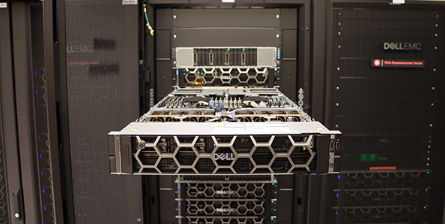The Ohio Supercomputer Center today announced “Cardinal,” an HPC cluster (test node is pictured here) that the center said doubles its AI processing capacity. The system is scheduled to be launched in the second half of this year.
A collaboration including Intel, Dell Technologies, Nvidia and the OSC, Cardinal (the state bird of Ohio) is a heterogeneous system with Dell PowerEdge servers and:
- 756 Intel Max Series CPU 9470 processors providing 39,312 total CPU cores, 128 gigabytes (GB) HBM2e and 512 GB of DDR5 memory per node
- 32 nodes that will have 104 cores, 1 terabyte) of memory, and four Nvidia Hopper architecture-based H100 Tensor Core GPUs with 94 GB HBM2e memory interconnected by four NVLink connections
- Nvidia Quantum-2 InfiniBand providing 400 gigabits per second of networking performance to deliver 500 petaflops of peak AI performance (FP8 Tensor Core, with sparsity) for AI-driven scientific applications
- 16 nodes that will have 104 cores, 128 GB HBM2e, and 2 TB DDR5 memory for large symmetric multiprocessing style jobs
 With a single software stack and traditional programming models on the x86 base, the cluster will more than double OSC’s capabilities while addressing broadening use cases and allowing for easy adoption and deployment.
With a single software stack and traditional programming models on the x86 base, the cluster will more than double OSC’s capabilities while addressing broadening use cases and allowing for easy adoption and deployment.
Cardinal will join OSC’s existing clusters Pitzer (2018, expanded in 2020) and Ascend (2022) on the OSC data center floor at the State of Ohio Computer Center. Cardinal will replace the Owens cluster, which will remain in service for three months after Cardinal starts production.
“The Intel Xeon CPU Max Series is an optimal choice for developing and implementing HPC and AI workloads, leveraging the most widely adopted AI frameworks and libraries,” said Ogi Brkic, vice president and general manager of Data Center AI Solutions product line at Intel. “The inherent heterogeneity of this system will empower OSC’s engineers, researchers, and scientists, enabling them to fully exploit the doubled memory bandwidth performance it offers. We take pride in supporting OSC and our ecosystem with solutions that significantly expedite the analysis of existing and future data for their targeted focus areas.”




